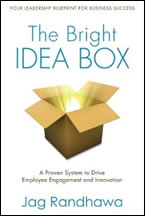Article first published as Book Review: ‘The Bright Idea Box’ by Jag Randhawa on Blogcritics.
Read Tyler's interview with Jag Randhawa.
January 4, 2014
The Bright Idea Box:
A Proven System to Drive Employee Engagement and Innovation
Jag Randhawa
Aviva Publishing (2014)
ISBN: 9781938686818
New Book Promotes Employee Involvement in Creating Company Innovation
 The news headlines are continually filled with stories about what is wrong with corporate America, but there are also people within corporate America who are trying to change that, who believe not in greed but in making the workplace a pleasant place to work, a place where employees feel ownership for their jobs, enjoy their work, and are appreciated for their accomplishments. Jag Randhawa is one of those people, and his new book The Bright Idea Box offers a simple, proven, and highly effective way to create a workplace environment where both the company and the employees’ best interests can be met.
The news headlines are continually filled with stories about what is wrong with corporate America, but there are also people within corporate America who are trying to change that, who believe not in greed but in making the workplace a pleasant place to work, a place where employees feel ownership for their jobs, enjoy their work, and are appreciated for their accomplishments. Jag Randhawa is one of those people, and his new book The Bright Idea Box offers a simple, proven, and highly effective way to create a workplace environment where both the company and the employees’ best interests can be met.
Randhawa begins with a simple idea—having a company suggestion box—not a new concept certainly, but also one that has never been discussed to such a degree as in these pages. Randhawa demonstrates how to make that suggestion box into a useful tool to improve a business and a workplace environment. Building on the work of other business experts like Jim Collins and his book Good to Great, Randhawa explores what makes companies successful and innovative, and he brings it back to the importance of having the right employees who are engaged in their work but also given the liberty to work on their own projects and feel a sense of ownership for their work. To achieve that kind of a work environment, a successful process needs to exist to implement the suggestions.
That process Randhawa calls the Six-Step MASTER Innovation program—“MASTER” being an acronym for the six steps: Mobilize, Amass, Support, Triage, Execute, and Recognize. I won’t go into the details of these steps here, but I will simply say that Randhawa walks us through how to clarify with employees what are productive suggestions, how suggestions should really be ideas that can benefit the company, and how to implement those ideas so everyone in the company is onboard and believes in the idea’s purpose and achievement. Included also are ways to reward employees for their ideas and the ideas’ successful implementation.
Clear examples are used throughout the book, including those from numerous other companies, of successfully implemented innovation programs. Among those companies cited are well-known ones such as Starbucks and 3M but also lesser known foreign companies such as Brasilata and examples from Randhawa’s own personal work experiences.
Randhawa himself knows how important it is to get employee buy-in to implement ideas and to make a company successful. Born and raised on a farm in rural India, he understands how to do the best with what you have and has brought that idea to the corporate world. Today, he lives in Silicon Valley where he witnessed the dot-com bust and has seen technology companies both fail and succeed. He has more than twenty years of experience in the technology industry, and he knows well the role that the I.T. department can play in implementing any idea in a company and why it’s important to get I.T. employees onboard with the changes needed.
Having once been a call center manager, I could appreciate many of the issues and processes Randhawa explored in this book about motivating employees. I wish I had read this book back then because I know it would have made my job easier, especially in terms of articulating to my employees not only that I wanted their ideas so we could improve things—something I always asked for—but how to formulate and think through those ideas so they could be implemented and achieve the results we all desired not only to make the company profitable but an enjoyable place to work.
I recommend this book to anyone who works in a business, from the CEO to the entry level employee. It will teach bosses how to create loyal and happy employees, and it will teach employees how to succeed in their jobs by better understanding what management needs from them. The Bright Idea Box offers a practical solution that will resolve any feelings of Us vs. Them between employers and employees and lead to what everyone in the workplace ultimately wants—the satisfaction of a job well done and feeling appreciated for it.
For more information about Jag Randhawa and The Bright Idea Box, visit www.TheBrightIdeaBox.com. Read Tyler's interview with Jag Randhawa.
— Tyler R. Tichelaar, Ph.D. and award-winning author of The Best Place

